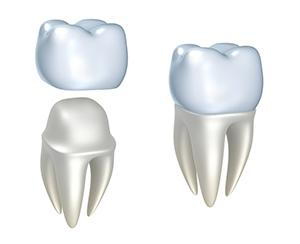
The Benefits of Dental Crowns
- posted: Dec. 26, 2018
Restorative procedures, such as root canals and dental implants, need crowns to cover them. Your dentist, Dr. James Zimmerman, provides patients with reliable crowns from his Woodland, CA, office—read below to learn the benefits of this treatment option!
 More About Dental Crowns
More About Dental Crowns
This dental prosthetic looks like a cap and is made of porcelain. To create them, your dentist takes an impression of your teeth and sends them to a lab where custom crowns are made for you (you'll be given a temporary crown in the meantime).
Crowns are also made of porcelain-fused-to-metal and porcelain with zirconia, one of the strongest ceramics available. Your Woodland dentist can help you determine which type would work best for your situation.
Crowns are crucial for protecting exposed teeth that may be susceptible to breakage and decay. Given how they reinforce teeth to help withstand various degrees of pressure, with crowns you can enjoy eating without the worry of damaging your teeth.
Dental Crown Uses
Dental crowns have other uses as well.
They're used for:
- Attaching bridges
- Covering an almost dislodged filling
- Hiding stained, or discolored teeth
Caring For Dental Crowns
Proper oral and dental care consists of preventative measures to keep natural teeth and crowns healthily intact for as long as possible. This requires that you,
- Brush your teeth twice a day and floss before bed to remove plaque buildup
- Don't bite into ice, as it can damage your teeth
- Visit your dentist twice a year for regular check-ups and professional dental cleanings
- Drink plenty of water to wash away food debris that may get stuck between teeth
- Get a mouth guard or splints if you suffer from bruxism (teeth grinding) since it reduces the crown's lifespan.
- Avoid unhealthy, sugary food, like candy and soda.
For more information on dental crowns and what they can do for you, contact Dr. James Zimmerman's Woodland, CA, practice at (530) 661-1155.
This website includes materials that are protected by copyright, or other proprietary rights. Transmission or reproduction of protected items beyond that allowed by fair use, as defined in the copyright laws, requires the written permission of the copyright owners.
